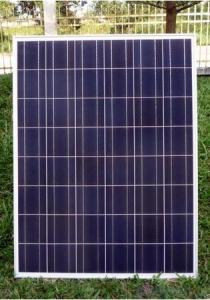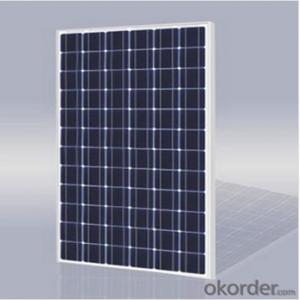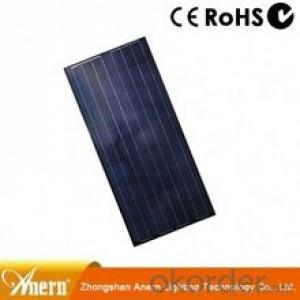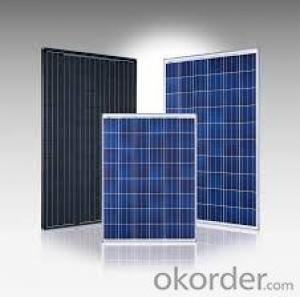156mm Poly Solar Cell for 250W Solar Panel Wholesaler Price
- Loading Port:
- Shanghai
- Payment Terms:
- TT OR LC
- Min Order Qty:
- 26 watt
- Supply Capability:
- 5000 watt/month
OKorder Service Pledge
OKorder Financial Service
You Might Also Like
Item specifice
156x156mm 3BB Poly Solar Cells 6x6 with Sperior Quality for Solar Panel
Feature
1.High conversion efficiencies resulting in superior power output performance.
2.Outstanding power output even in low light or high temperature conditions
3.Optimized design for ease of soldering and lamination
4.Long-term stability,reliability and performance
5.Low breakage rate
6.Color uniformaity

Physical characteristic
Dimension: 156*156mm±0.5mm
Thickness: wafer(Si):200μm±20μm
Cell:240μm±40μm
Front: silver bus bars;dark blue/others silicon nitride anti reflection coating
Back: silver/aluminum bus bars;full-surface aluminum BSF
Warranty
25-years limited warranty on power output: 10 years/90%, 25 years/80%
Packaging
The solar cells are packed in cartons, and then pallet.
Shipping by sea or by air are both ok, it's up to customer’s choice.
We’d like to inquire the freight cost for customer after be informed exact quantity and destination address
Special service we offer:
give credit for 90 days for those who has good reputation and would like to establish long term relationship with us.
- Q:What is the role of maximum power point tracking in solar cell systems?
- The role of maximum power point tracking (MPPT) in solar cell systems is to ensure that the solar panels operate at their most efficient point of power generation. MPPT algorithms continuously adjust the operating voltage and current of the solar panels to track the maximum power point, which is the point where the panels produce the maximum power output for a given set of environmental conditions. By optimizing the power output, MPPT increases the overall efficiency and performance of the solar cell system, maximizing the energy harvest from the sun.
- Q:I know that solar cells are produced by DC and then converted into alternating current through the inverter, who explains why the solar cell is produced by DC?
- The key is to have a magnetic field change. Of course, there is no solar energy. There are only energy changes.
- Q:Are solar cells affected by extreme temperatures?
- Yes, solar cells can be affected by extreme temperatures. High temperatures can cause the efficiency of solar cells to decrease, as excessive heat can cause an increase in resistance and reduce the voltage output. Similarly, extremely cold temperatures can also impact their performance, although to a lesser extent. It is important to note that modern solar cells are designed to withstand a wide range of temperatures, and their efficiency is typically optimized within a specific temperature range.
- Q:Can solar cells be used for powering remote military installations?
- Yes, solar cells can be used for powering remote military installations. Solar power systems provide a reliable and sustainable source of energy, making them an ideal solution for remote locations where access to traditional power grids may be limited or unavailable. Solar cells can efficiently convert sunlight into electricity, providing a consistent power supply to support the energy needs of military bases, communication systems, surveillance equipment, and other critical infrastructure in remote areas. Additionally, solar power reduces reliance on fossil fuels, enhances operational flexibility, and promotes environmental sustainability in military operations.
- Q:What is the impact of solar cells on wildlife?
- Solar cells have a minimal impact on wildlife compared to other forms of energy generation. While some studies suggest that solar farms can disrupt or displace certain species, the overall impact is considered low. The installation of solar panels can provide shade and shelter for certain animals, and the reduction in greenhouse gas emissions associated with solar energy helps mitigate the effects of climate change on wildlife habitats.
- Q:How do solar cells perform in areas with high levels of electromagnetic interference?
- Solar cells may be affected by high levels of electromagnetic interference (EMI) in areas where strong electromagnetic fields or radio frequency signals are present. EMI can disrupt the normal functioning of solar cells, leading to reduced efficiency or even complete failure in extreme cases. To overcome this issue, it is important to employ proper shielding and grounding techniques to minimize the impact of EMI on solar cells. Additionally, advanced designs and technologies are constantly being developed to enhance the EMI tolerance of solar cells, ensuring their optimal performance even in areas with high levels of electromagnetic interference.
- Q:What is a monocrystalline solar cell?
- A monocrystalline solar cell is a type of solar cell made from a single crystal structure, typically of silicon. It is known for its high efficiency in converting sunlight into electricity due to its uniform crystal lattice structure, which allows for better electron flow. Monocrystalline solar cells are widely used in photovoltaic systems due to their excellent performance and durability.
- Q:What is the role of solar cells in powering electric vehicles?
- Solar cells play a crucial role in powering electric vehicles by harnessing sunlight and converting it into electricity. They are typically installed on the roof of the vehicle, or integrated into its body, and generate renewable energy which can be used to charge the vehicle's battery. While solar power alone may not be sufficient to fully power an electric vehicle, it can significantly extend its range and reduce the reliance on grid electricity. Additionally, solar cells provide a sustainable and environmentally friendly solution, contributing to the overall goal of reducing carbon emissions and promoting clean energy transportation.
- Q:How do solar cells handle electromagnetic pulses?
- Solar cells are generally not designed to handle electromagnetic pulses (EMPs) directly. EMPs can cause a sudden surge in electrical energy, which can potentially damage or destroy electronic devices, including solar cells. However, solar cells usually have built-in protection mechanisms and are often shielded by other components in a solar panel system, such as inverters or charge controllers, which can help mitigate the effects of EMPs. Additionally, the impact of EMPs on solar cells can vary depending on factors such as the magnitude and proximity of the pulse, as well as the quality and design of the solar cell system.
- Q:What is the impact of solar cells on reducing noise pollution from power generation?
- Solar cells have a minimal impact on reducing noise pollution from power generation since they operate silently, unlike traditional power plants that emit noise during operation.
1. Manufacturer Overview |
|
|---|---|
| Location | |
| Year Established | |
| Annual Output Value | |
| Main Markets | |
| Company Certifications | |
2. Manufacturer Certificates |
|
|---|---|
| a) Certification Name | |
| Range | |
| Reference | |
| Validity Period | |
3. Manufacturer Capability |
|
|---|---|
| a)Trade Capacity | |
| Nearest Port | |
| Export Percentage | |
| No.of Employees in Trade Department | |
| Language Spoken: | |
| b)Factory Information | |
| Factory Size: | |
| No. of Production Lines | |
| Contract Manufacturing | |
| Product Price Range | |
Send your message to us
156mm Poly Solar Cell for 250W Solar Panel Wholesaler Price
- Loading Port:
- Shanghai
- Payment Terms:
- TT OR LC
- Min Order Qty:
- 26 watt
- Supply Capability:
- 5000 watt/month
OKorder Service Pledge
OKorder Financial Service
Similar products
New products
Hot products
Hot Searches
Related keywords



























